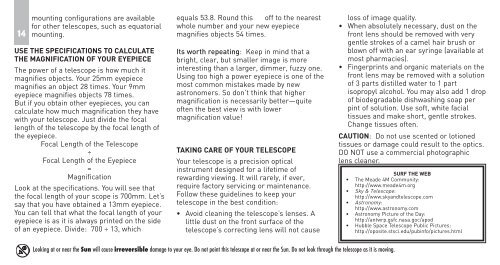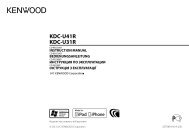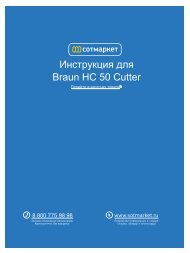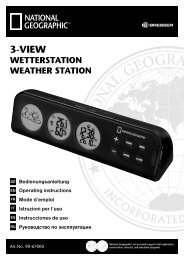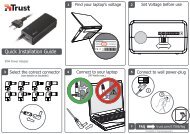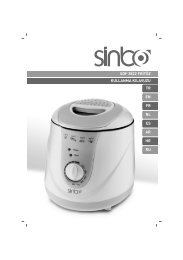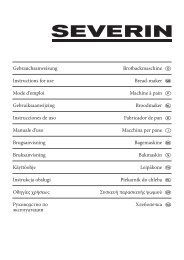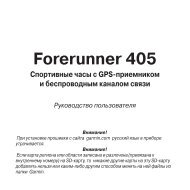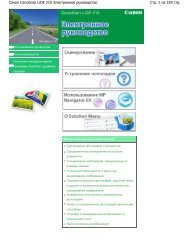TerraStar 60 Manual - Meade
TerraStar 60 Manual - Meade
TerraStar 60 Manual - Meade
Create successful ePaper yourself
Turn your PDF publications into a flip-book with our unique Google optimized e-Paper software.
14<br />
mounting configurations are available<br />
for other telescopes, such as equatorial<br />
mounting.<br />
USE THE SPECIFICATIONS TO CALCULATE<br />
THE MAGNIFICATION OF YOUR EYEPIECE<br />
The power of a telescope is how much it<br />
magnifies objects. Your 25mm eyepiece<br />
magnifies an object 28 times. Your 9mm<br />
eyepiece magnifies objects 78 times.<br />
But if you obtain other eyepieces, you can<br />
calculate how much magnification they have<br />
with your telescope. Just divide the focal<br />
length of the telescope by the focal length of<br />
the eyepiece.<br />
Focal Length of the Telescope<br />
÷<br />
Focal Length of the Eyepiece<br />
=<br />
Magnification<br />
Look at the specifications. You will see that<br />
the focal length of your scope is 700mm. Let’s<br />
say that you have obtained a 13mm eyepiece.<br />
You can tell that what the focal length of your<br />
eyepiece is as it is always printed on the side<br />
of an eyepiece. Divide: 700 ÷ 13, which<br />
equals 53.8. Round this off to the nearest<br />
whole number and your new eyepiece<br />
magnifies objects 54 times.<br />
Its worth repeating: Keep in mind that a<br />
bright, clear, but smaller image is more<br />
interesting than a larger, dimmer, fuzzy one.<br />
Using too high a power eyepiece is one of the<br />
most common mistakes made by new<br />
astronomers. So don’t think that higher<br />
magnification is necessarily better—quite<br />
often the best view is with lower<br />
magnification value!<br />
TAKING CARE OF YOUR TELESCOPE<br />
Your telescope is a precision optical<br />
instrument designed for a lifetime of<br />
rewarding viewing. It will rarely, if ever,<br />
require factory servicing or maintenance.<br />
Follow these guidelines to keep your<br />
telescope in the best condition:<br />
• Avoid cleaning the telescope’s lenses. A<br />
little dust on the front surface of the<br />
telescope’s correcting lens will not cause<br />
loss of image quality.<br />
• When absolutely necessary, dust on the<br />
front lens should be removed with very<br />
gentle strokes of a camel hair brush or<br />
blown off with an ear syringe (available at<br />
most pharmacies).<br />
• Fingerprints and organic materials on the<br />
front lens may be removed with a solution<br />
of 3 parts distilled water to 1 part<br />
isopropyl alcohol. You may also add 1 drop<br />
of biodegradable dishwashing soap per<br />
pint of solution. Use soft, white facial<br />
tissues and make short, gentle strokes.<br />
Change tissues often.<br />
CAUTION: Do not use scented or lotioned<br />
tissues or damage could result to the optics.<br />
DO NOT use a commercial photographic<br />
lens cleaner.<br />
SURF THE WEB<br />
• The <strong>Meade</strong> 4M Community:<br />
http://www.meade4m.org<br />
• Sky & Telescope:<br />
http://www.skyandtelescope.com<br />
• Astronomy:<br />
http://www.astronomy.com<br />
• Astronomy Picture of the Day:<br />
http://antwrp.gsfc.nasa.goc/apod<br />
• Hubble Space Telescope Public Pictures:<br />
http://oposite.stsci.edu/pubinfo/pictures.html<br />
Looking at or near the Sun will cause irreversible damage to your eye. Do not point this telescope at or near the Sun. Do not look through the telescope as it is moving.


